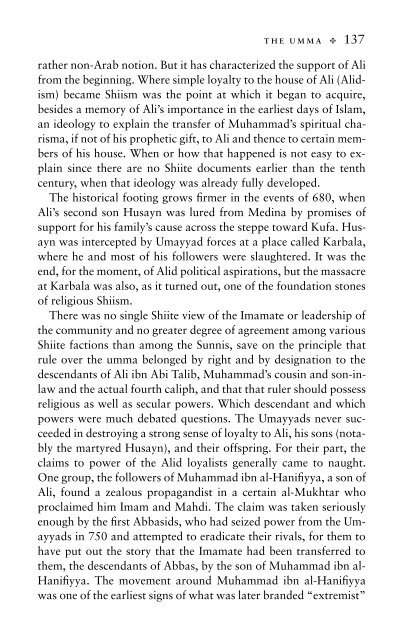Islam: A Guide for Jews and Christians - Electric Scotland
Islam: A Guide for Jews and Christians - Electric Scotland
Islam: A Guide for Jews and Christians - Electric Scotland
You also want an ePaper? Increase the reach of your titles
YUMPU automatically turns print PDFs into web optimized ePapers that Google loves.
THE UMMA t 137<br />
rather non-Arab notion. But it has characterized the support of Ali<br />
from the beginning. Where simple loyalty to the house of Ali (Alidism)<br />
became Shiism was the point at which it began to acquire,<br />
besides a memory of Ali’s importance in the earliest days of <strong>Islam</strong>,<br />
an ideology to explain the transfer of Muhammad’s spiritual charisma,<br />
if not of his prophetic gift, to Ali <strong>and</strong> thence to certain members<br />
of his house. When or how that happened is not easy to explain<br />
since there are no Shiite documents earlier than the tenth<br />
century, when that ideology was already fully developed.<br />
The historical footing grows firmer in the events of 680, when<br />
Ali’s second son Husayn was lured from Medina by promises of<br />
support <strong>for</strong> his family’s cause across the steppe toward Kufa. Husayn<br />
was intercepted by Umayyad <strong>for</strong>ces at a place called Karbala,<br />
where he <strong>and</strong> most of his followers were slaughtered. It was the<br />
end, <strong>for</strong> the moment, of Alid political aspirations, but the massacre<br />
at Karbala was also, as it turned out, one of the foundation stones<br />
of religious Shiism.<br />
There was no single Shiite view of the Imamate or leadership of<br />
the community <strong>and</strong> no greater degree of agreement among various<br />
Shiite factions than among the Sunnis, save on the principle that<br />
rule over the umma belonged by right <strong>and</strong> by designation to the<br />
descendants of Ali ibn Abi Talib, Muhammad’s cousin <strong>and</strong> son-inlaw<br />
<strong>and</strong> the actual fourth caliph, <strong>and</strong> that that ruler should possess<br />
religious as well as secular powers. Which descendant <strong>and</strong> which<br />
powers were much debated questions. The Umayyads never succeeded<br />
in destroying a strong sense of loyalty to Ali, his sons (notably<br />
the martyred Husayn), <strong>and</strong> their offspring. For their part, the<br />
claims to power of the Alid loyalists generally came to naught.<br />
One group, the followers of Muhammad ibn al-Hanifiyya, a son of<br />
Ali, found a zealous propag<strong>and</strong>ist in a certain al-Mukhtar who<br />
proclaimed him Imam <strong>and</strong> Mahdi. The claim was taken seriously<br />
enough by the first Abbasids, who had seized power from the Umayyads<br />
in 750 <strong>and</strong> attempted to eradicate their rivals, <strong>for</strong> them to<br />
have put out the story that the Imamate had been transferred to<br />
them, the descendants of Abbas, by the son of Muhammad ibn al-<br />
Hanifiyya. The movement around Muhammad ibn al-Hanifiyya<br />
was one of the earliest signs of what was later br<strong>and</strong>ed “extremist”
















